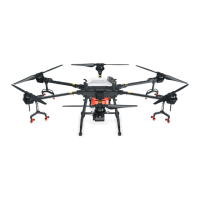2
©
2019 DJI All Rights Reserved.
Safety at a Glance
1. Pesticide Usage
•
Avoid the use of powder pesticides as much as possible
as they may reduce the service life of the spraying
system.
•
Pesticides are poisonous and pose serious risks to
safety. Only use them in strict accordance with their
specications.
•
Residue on the equipment caused by splashes or spills
when pouring and mixing the pesticide can irritate your
skin. Make sure to clean the equipment after mixing.
•
Use clean water to mix the pesticide and filter the mixed liquid before pouring into the spray tank to
avoid blocking the strainer. Clear any blockage before using the equipment.
•
Make sure to stay in an upwind area when spraying pesticide to avoid bodily harm.
•
Wear protective clothingto prevent direct body contact with the pesticide. Rinse your hands and
skin after handling pesticides. Clean the aircraft and remote controller after applying the pesticide.
•
Effective use of pesticides depends on pesticide density, spray rate, spray distance, aircraft speed,
wind speed, wind direction, temperature, and humidity. Consider all factors when using pesticides,
but DO NOT compromise the safety of people, animals, or the environment in doing so.
•
DO NOT contaminate rivers and sources of drinking water.
2. Environmental Considerations
•
Always fly at locations that are clear of buildings and other obstacles. DO NOT fly above or near
large crowds.
•
The recommended maximum operating altitude is 2 km (6,560 ft) above sea level. DO NOT fly over
3 km (9,842 ft) above sea level.
•
Only fly in moderate weather conditions with temperatures between 0° to 40° C (32° to 104° F).
•
Make sure that your operations do not violate any applicable laws or regulations, and that you have
obtained all appropriate prior authorizations. Consult the relevant government agency or authority,
or your lawyer before flight to ensure you comply with all relevant laws and regulations.
•
DO NOT operate any part of the aircraft indoors.
3. Pre-Flight Checklist
Make sure to check all of the following:
•
Remote controller and aircraft batteries are fully charged.
•
All parts are in good condition. Replace aged or broken parts before flight.
•
Landing gear and spray tankare firmly in place.
•
Propellers and frame arms are unfolded and arm sleeves are firmly tightened. Propellers are in
good condition and rmly tightened. There is nothing obstructing the motors and propellers.
•
Spraying system is not blocked and works properly.
•
Compass is calibrated after being prompted to do so in the app.
The AGRAS
TM
T16 aircraft
is not a toy and is not
suitable for children under
the age of 18.
Note that the Safety at a Glance section
only provides a quick overview of the
safety tips. Make sure you read and
understand this document and the
user manual.

